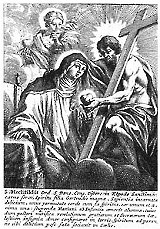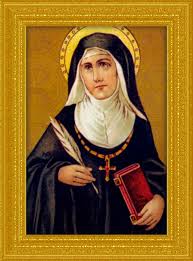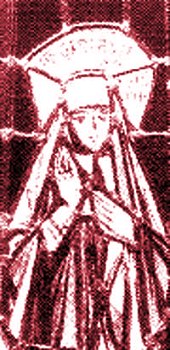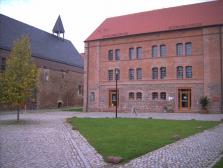Above all, keep fervent in your love for one another, because love covers a multitude of sins. Be hospitable to one another without complaint. As each one has received a special gift, employ it in serving one another as good stewards of the manifold grace of God. Whoever speaks, is to do so as one who is speaking the utterances of God; whoever serves is to do so as one who is serving by the strength which God supplies; so that in all things God may be glorified through Jesus Christ, to whom belongs the glory and dominion forever and ever. Amen. (I Peter 4:8-11)
This summer we have looked at some amazing lives of the Christian women who lived during the Middle Ages. These women all sought to grow closer to God and to follow in the footsteps of the Savior by serving the poor. There were a number of ways they accomplished their goals of piety and charity.
Some women, such as Mary of Oignies and Hadewijch were Beguines. The Beguines did not take vows but made their own rules. They were all encouraged to read and study. They were expected to support themselves. Some came with rich inheritances that they shared with everyone. Others learned trades, especially in the cloth industry.
The independent lifestyle of the Beguines helped them to work with the poor and marginalized without having to be under the control of local bishops or noblemen. They did not want to be like the nuns who were often not allowed to leave the cloisters. The Beguines wanted the freedom to choose to work among the poor in their own way.
A few women became “anchoresses”. They took vows. They lived alone, usually in a cell attached to a church. They often had windows to use for light and business. One window faced the altar. Elizabeth of Spalbeek (see last week’s post) was an anchoress.
Many women, like Clare of Assisi (founder of the Poor Clares), wanted to attach themselves to a religious order that they admired. Clare joined the 3rd Order of the Franciscans. These “tertiaries” were not quite nuns, not quite lay people. They took vows of poverty. They had a little more independence than the nuns. They loved Christ enough to devote their whole lives to Him. They showed their love through acts of mercy. Their independence allowed them to travel while they ministered.
Other women sought the safety and protection of a cloister to serve Christ. The monastic movement had begun centuries earlier. It went through many changes. In the Middle Ages many monasteries followed the order of St. Benedict. They took vows of poverty, chastity, and obedience. The nuns who lived in the monasteries sought to live a Gospel life. There was a loose style of democracy. The nuns often voted for their own abbess. Usually the cloister was under the authority of a priest or bishop.
Women sought a life of service in the church for various reasons. Some were widowed. Some had not found a marriage partner. Some were orphaned. Many just wanted to follow in Christ’s footsteps as their calling. Some joined a convent because they could get an education there. In the monastery/cloister women had access to the Scriptures and many other books. Art, drama, and music flourished in the cloisters.
One very famous cloister was the Helfta Convent. Three famous women lived at this convent – Mechthild of Magdeburg, Mechthild of Hackeborn, and Gertude (The Great) of Helfta. This convent was located near Eiselben in Saxony. It became famous as an intellectual and spiritual center for women. The women were known for their scientific work, art, and music. It was a center of mysticism as well.
Young girls and orphans were accepted at Helfta for schooling. The sisters also were skilled in craftwork, especially the making of books. Their choir was also renowned.
Mechthild of Magdeburg (1210-c.1280)
 Mechthild was born into a noble family and most likely grew up at a small court. At the age of twelve she received the first of a series of “greetings” from the Holy Spirit. These divine encounters had a great effect on her and when she was nineteen she decided to devote her life to God. Mechthild became a Beguine and eventually became the abbess of her group. She was highly educated and had great writing abilities.
Mechthild was born into a noble family and most likely grew up at a small court. At the age of twelve she received the first of a series of “greetings” from the Holy Spirit. These divine encounters had a great effect on her and when she was nineteen she decided to devote her life to God. Mechthild became a Beguine and eventually became the abbess of her group. She was highly educated and had great writing abilities.
She continued to have visions but did not reveal them to anyone until she was in her forties. She had a friend and confessor, the Dominican Heinrich of Halle, who persuaded her to document them. Mechthild spent years writing down her love songs and visionary experiences, carefully shaping her words as God directed her. Her writings were quickly copied and circulated.
Mechthild wrote in a Low German dialect. Her masterpiece, The Flowing Light of the Godhead, was comprised of seven books that contain beautiful prose, poetry, visions, letters, parables, reflections, allegories, prayers, criticism, and advice. These books give a picture of Mechthild’s journey toward God. They are still widely read today. Mechthild wrote these books as a message to both lay believers and the clergy. She was concerned about the laxity in the church.
As an older woman, Mechthild’s life was fraught with difficulties. The church began to persecute the Beguines. She, as well as others, had been critical of the immorality of the local priests. In retaliation, the church tried to place restrictions on the Beguines. Mechthild may have decided to join a cloister rather than submit to a parish priest. Around 1270 Mechthild joined the monastery at Helfta. The abbess, Gertrude was happy to welcome Mechthild into the Cistertian community of gifted and pious nuns.
Here Mechthild continued to write until her death.
Mechthild of Hackeborn (1241-c.1298)
Mechthild joined the convent when she was seven years old. She was very gifted  musically. She became the choir director and the chantress and was called “the nightingale of Christ”.
musically. She became the choir director and the chantress and was called “the nightingale of Christ”.
Mechthild had experienced mystical visions since childhood but like our other Mechthild (of Magdeburg) she was reluctant to reveal them to anyone until she was nearly fifty years old. Even then she shied away from writing. Two members of the community (one of whom might possibly have been Gertrude, see below) compiled them, at first without her knowledge, into a work composed of five books – the Book of Special Grace. After her death another book was composed telling of her life and death. These books became very influential in their day.
Gertrude the Great of Helfta (1256-1302)
 Gertrude joined the convent when she was only five years old. Unlike the two Mechthild’s she was not nobly born and was probably an orphan. At a very young age she showed great intellectually ability. She was educated by the gifted Mechthild of Hackeborn. Gertrude studied science, art, and theology. She spoke and wrote Latin and Greek fluently. She translated parts of the Bible into German.
Gertrude joined the convent when she was only five years old. Unlike the two Mechthild’s she was not nobly born and was probably an orphan. At a very young age she showed great intellectually ability. She was educated by the gifted Mechthild of Hackeborn. Gertrude studied science, art, and theology. She spoke and wrote Latin and Greek fluently. She translated parts of the Bible into German.
Gertrude experienced her first vision when she was twenty-six years old. She later said that it was the most important day of her life. Gertrude had been living a life of pretense. When she had her vision she turned her life over to Christ, finding a new joy in her Christian life.
In her book, “The Herald of Divine Love” she says, “My God, you who are all truth, clearer than all light, yet hidden deeper in our heart than any secret, when you yourself resolved to disperse the darkness of my night, you began gently and tenderly by first calming my mind, which had been troubled for more than a month past. This trouble it seems to me served your purpose. You were striving to destroy the tower of vanity and worldliness which I had set up in my pride, although, alas, I was – in vain – bearing the name and wearing the habit of a religious. … From that hour, in a new spirit of joyful serenity I began to follow the way of the sweet odor of your perfumes (Song 1:3) and I found your yoke sweet and your burden light (Matt. 11:30) which a short time before I had thought to be unbearable.”
Gertrude’s important books are – “The Herald of Divine Love” and ‘The Spiritual Exercises”. These books teach the priority of service to the poor over the pleasure of private prayer. Glimpses of pious community life come through these writings.
The Helfta Convent was an outstanding place for women especially during the Medieval age. Founded in 1229 in the grounds of Mansfeld castle, it moved to the village of Helfta in 1258. The buildings were destroyed and rebuilt many times. In 1542 the land was secularized and fell into disrepair. In 1950 the land was returned to the people of the GDR and became a community fruit farm. In 1994 the “Friends of Helfta”, German Catholics, collected funds to purchase all of the buildings and 30 acres. In 1998 restoration work began. In 1999 Cistercian Nuns from Seligenthal, Bavaria moved into the convent.
Medieval age. Founded in 1229 in the grounds of Mansfeld castle, it moved to the village of Helfta in 1258. The buildings were destroyed and rebuilt many times. In 1542 the land was secularized and fell into disrepair. In 1950 the land was returned to the people of the GDR and became a community fruit farm. In 1994 the “Friends of Helfta”, German Catholics, collected funds to purchase all of the buildings and 30 acres. In 1998 restoration work began. In 1999 Cistercian Nuns from Seligenthal, Bavaria moved into the convent.
Today the convent remains a place for women to live, pray, and work. The convent is considered a center of spirituality. You can actually visit. They host seminars, retreats, and spiritual exercises, short-stays, and guided tours.

